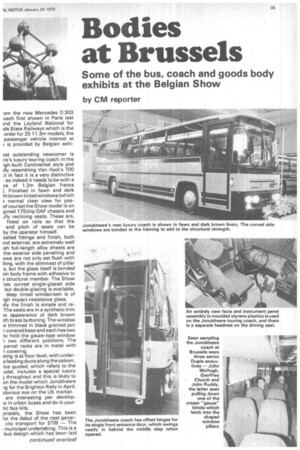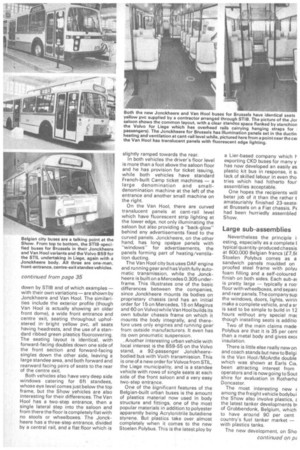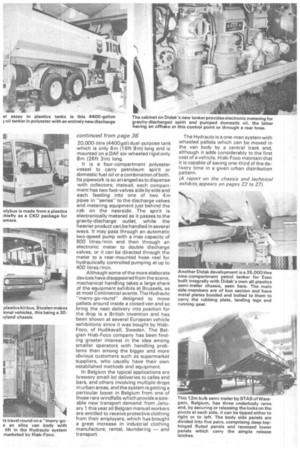Bodies at Brussels
Page 37

Page 38

Page 41

If you've noticed an error in this article please click here to report it so we can fix it.
Some of the bus, coach and goods body exhibits at the Belgian Show
by CM reporter
.om the new Mercedes 0.303 oach first shown in Paris last md the Leyland National for ids State Railways which is the order for 25 11.3m models, the passenger vehicle interest at
r is provided by Belgian exhi ost outstanding newcomer is re's luxury touring coach in the igh-built Continental style and illy resembling Van Hool's 700 it in fact it is a very distinctive as indeed it needs to be with a ce of 1.2m Belgian francs ). Finished in fawn and dark th brown tinted windows (which normal clear view for pasof course) the Show model is on gined 175 bhp DAF chassis and illy reclining seats. These are, fitted on rails so that the and pitch of seats can be by the operator himself.
tailed fittings and finish, both Ind external, are extremely well ish full-length alloy sheets are the exterior side panelling and ows are not only set flush with !ling, with the slimmest of pillar s, but the glass itself is bonded min body frame with adhesive to 3 structural member. The Show las curved single-glazed side but double-glazing is available.
deep tinted windscreen is of igh impact-resistance glass.
illy the finish is simple and reThe seats are in a synthetic trim ie appearance of dark brown ith brass buttoning. The window e trimmed in black grained pvc 1-covered base and each has two to hold the gauze-type window -1 two different positions. The parcel racks are in metal with -1 covering.
iting is at floor level, with under s feeding ducts along the saloon. ice quoted, which refers to the odel, includes a special luxury 3 throughout and this is likely to on the model which Jonckheere
for the Brighton Rally in April, obvious eye on the UK market. are interesting psv develop,o in urban buses and do-it-yourtic bus kits.
oriately, the Show has been or the debut of the next genercity transport for STIB — The . municipal undertaking. This is a bus design which has been laid down by STIB and of which examples — with their own variations— are shown by Jonckheere and Van Hoot. The similarities include the exterior profile (though Van Hool is actually showing an older front dome), a wide front entrance and centre 'exit, seating throughout upholstered in bright yellow pvc, all seats having headrests, and the use of a standard ribbed green plastics floorcovering. The seating layout is identical, with forward-facing doubles down one side of the front section and forward-facing singles down the other side, leaving a large standee area, and both forward and rearward facing pairs of seats to the rear of the centre exit.
Both vehicles also have very deep side windows catering for 6ft standees, whose eye level comes just below the tap frame, but the Show vehicles are also interesting for their differences. The Van Hoot has a two-step entrance, then a single lateral step into the saloon and from there the floor is completely flat with no stools or wheelboxes. The Jonckheere has a three-step entrance, divided by a central rail, and a flat floor which is slightly ramped towards the rear.
In both vehicles the driver's floor level is more than a foot above the saloon floor and he has provision for ticket issuing, while both vehicles have standard French-built Camp ticket machines — a large denomination and smalldenomination machine at the left of the entrance and another small machine on the right.
On the Van Hool, there are curved translucent panels at cant-rail level which have fluorescent strip lighting at the lower edge, not only illuminating the saloon but also providing a "back-glow" behind any advertisements fixed to the curved panels. Jonckheere, on the other hand, has long opaque panels with "windows" for advertisements, the panels forming part of heating/ventilation ducting.
The Van Hool city bus uses DAF engine and running gear and hasVoith fully auto matic transmission, while the Jonck heere is built on a Mercedes 0.305 underframe. This illustrates one of the basic differences between the companies, since Jonckheere mounts its bodies on proprietary chassis (and has an initial order for 15 on Mercedes, 15 on Magirus and 60 on Volvo) while Van Hool builds its own tubular chassis frame on which it mounts the body integrally, and therefore uses only engines and running gear' from outside manufacturers. It even has its own pneumatic suspension.
Another interesting urban vehicle with local interest is the B59-55 on the Volvo stand, a 92-passenger Jonckheere bodied bus with Voith transmission. This is one of a new order for Volvos from STIL, the Liege municipality, and is a standee vehicle with rows of single seats at each side of the front saloon and a very easy two-step entrance.
One of the significant features of the Belgian-built urban buses is the amount of plastics material now used in body structure and fittings, one of the most popular materials in addition to polyester apparently being Acrylonitrile butadiene styrene. But plastics take over almost completely when it comes to the new Stoelen Polybus. This is the latest ploy by a Lier-based company which I' exporting CKD buses for many y has now developed an easily as plastic kit bus in response, it Si lack of skilled labour in even tho tries which had hitherto four assemblies acceptable.
One hopes the recipients will beter job of it than the rather t amateurishly finished 23-seatel at Brussels on a Fiat chassis. PE had been hurriedly assembled Show.
Large sub-assemblies
Nevertheless the principle esting, especially as a complete I
typical quantity-produced chassis at 600,000 Belgian francs (.1'7 ,5( Stoelen Polybus comes as a sandwich panels moulded on
proofed steel frame with polyu foam filling and a self-coloured
finish on both sides. Each sub-ai is pretty large — typically a roo' floor with wheelboxes, and separE and rear panels. The company sup the windows, doors, lights, wirin make a complete vehicle, and a sr is said to be simple to build in 12 hours without any special ma( though installing seats is additio
Two of the main claims made Polybus are that it is 35 per cent than a metal body and gives exc( insulation.
There is little else really new on and coach stands but new to Belgi is the Van Hool/McArdle double which was shown at Earls Ca. been attracting interest from operators and is now going to Soul shire for evaluation in Rotherhz Doncaster.
The most interesting new t among the freight vehicle bodybui the Show also involve plastics, E the latest tanker developments bl of Grobbendonk, Belgium, which to have around 90 per cent country's fuel tanker market — with plastics tanks.
The new development, on Sho 20,000-litre (4400gal) dual-purpose tank which is only 6m (19ft Bin) long and is mounted on a DAF six-wheeled rigid only 8m (26ft 3m) long.
It is a four-compartment polyester vessel to carry petroleum spirit or domestic fuel oil or a combination of both. Its pipework is so arranged as to dispense with collectors; instead, each compartment has two foot-valves side by side and each feeding into one of two 4 in pipes in "series" to the discharge valves and metering equipment just behind the cab on the nearside. The spirit is electronically metered as it passes to the gravity-discharge outlet while the heavier product can be handled in several ways. It may pass through an automatic two-speed pump with a max capacity of 600 'litres/min and then through an electronic meter to double discharge valves, or it can be directed through the meter to a rear-mounted hose reel for hydraulically controlled pumping at up to 400 litres/min.
Although some of the more elaborate devices have disappeared from the scene, mechanical handling takes a large share of the equipment exhibits at Brussels, as at most Continental events. The Hydrauto "merry-go-round" designed to move pallets around inside a closed van and so bring the next delivery into position for the drop is a British invention and has been shown at several European vehicle exhibitions since it was bought by HiabFoco, of Hudiksvall, Sweden. The Belgian Hiab-Foco company has been finding greater interest in the idea among smaller operators with handling problems than among the bigger and more obvious customers such as supermarket suppliers, who usually have their own established methods and equipment.
In Belgium the typical applications are brewery small-lot deliveries to cafes and bars, and others involving multiple drops in urban areas, and the system is getting a particular boost in Belgium from one of those rare windfalls which provide a sizeable new transport demand: from January 1 this year all Belgian manual workers are entitled to receive protective clothing from their employers, which has brought a great increase in industrial clothing manufacture, rental, laundering — and transport. The Hydrauto is a one-man system with wheeled pallets which can be moved in the van body by a central track and, although it adds considerably to the first cost of a vehicle, Hiab-Foco maintain that it is capable of saving one-third of the delivery time in a given urban distribution pattern.
(A report on the chassis and technical exhibits appears on pages 22 to 27).




































































































